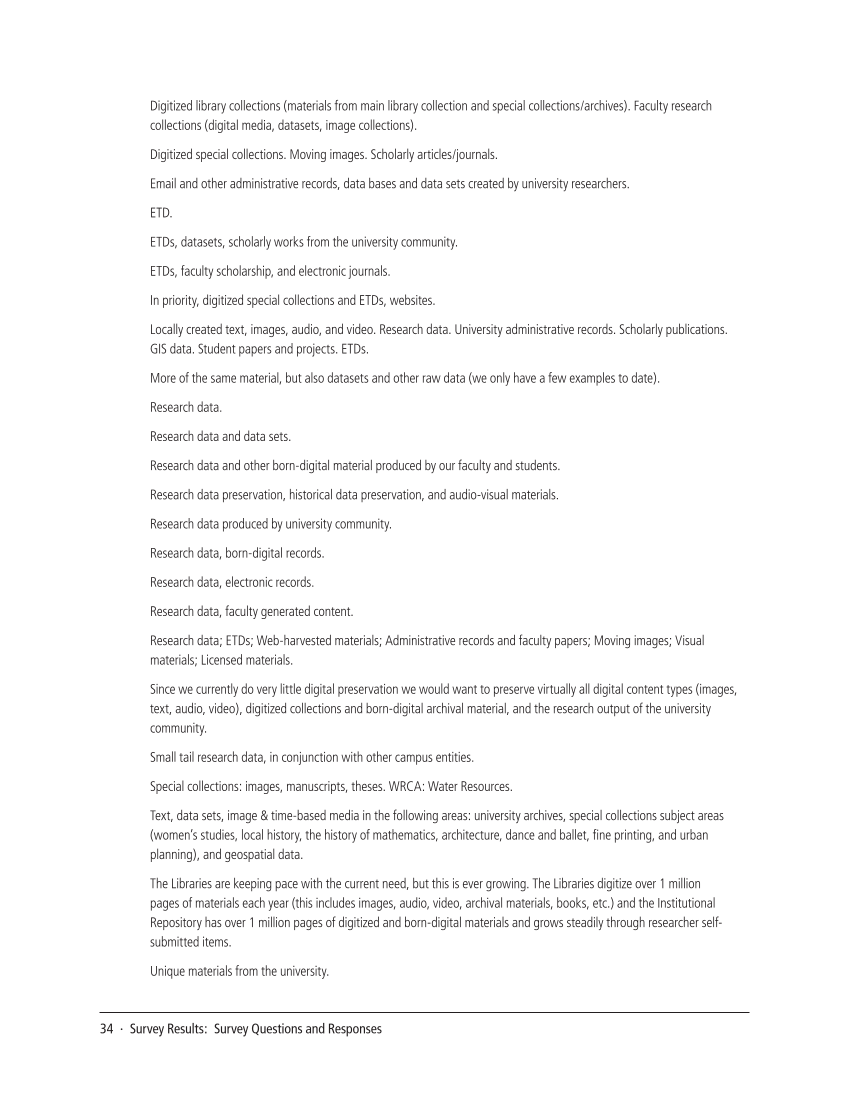34 · Survey Results: Survey Questions and Responses
Digitized library collections (materials from main library collection and special collections/archives). Faculty research
collections (digital media, datasets, image collections).
Digitized special collections. Moving images. Scholarly articles/journals.
Email and other administrative records, data bases and data sets created by university researchers.
ETD.
ETDs, datasets, scholarly works from the university community.
ETDs, faculty scholarship, and electronic journals.
In priority, digitized special collections and ETDs, websites.
Locally created text, images, audio, and video. Research data. University administrative records. Scholarly publications.
GIS data. Student papers and projects. ETDs.
More of the same material, but also datasets and other raw data (we only have a few examples to date).
Research data.
Research data and data sets.
Research data and other born-digital material produced by our faculty and students.
Research data preservation, historical data preservation, and audio-visual materials.
Research data produced by university community.
Research data, born-digital records.
Research data, electronic records.
Research data, faculty generated content.
Research data ETDs Web-harvested materials Administrative records and faculty papers Moving images Visual
materials Licensed materials.
Since we currently do very little digital preservation we would want to preserve virtually all digital content types (images,
text, audio, video), digitized collections and born-digital archival material, and the research output of the university
community.
Small tail research data, in conjunction with other campus entities.
Special collections: images, manuscripts, theses. WRCA: Water Resources.
Text, data sets, image &time-based media in the following areas: university archives, special collections subject areas
(women’s studies, local history, the history of mathematics, architecture, dance and ballet, fine printing, and urban
planning), and geospatial data.
The Libraries are keeping pace with the current need, but this is ever growing. The Libraries digitize over 1 million
pages of materials each year (this includes images, audio, video, archival materials, books, etc.) and the Institutional
Repository has over 1 million pages of digitized and born-digital materials and grows steadily through researcher self-
submitted items.
Unique materials from the university.
Digitized library collections (materials from main library collection and special collections/archives). Faculty research
collections (digital media, datasets, image collections).
Digitized special collections. Moving images. Scholarly articles/journals.
Email and other administrative records, data bases and data sets created by university researchers.
ETD.
ETDs, datasets, scholarly works from the university community.
ETDs, faculty scholarship, and electronic journals.
In priority, digitized special collections and ETDs, websites.
Locally created text, images, audio, and video. Research data. University administrative records. Scholarly publications.
GIS data. Student papers and projects. ETDs.
More of the same material, but also datasets and other raw data (we only have a few examples to date).
Research data.
Research data and data sets.
Research data and other born-digital material produced by our faculty and students.
Research data preservation, historical data preservation, and audio-visual materials.
Research data produced by university community.
Research data, born-digital records.
Research data, electronic records.
Research data, faculty generated content.
Research data ETDs Web-harvested materials Administrative records and faculty papers Moving images Visual
materials Licensed materials.
Since we currently do very little digital preservation we would want to preserve virtually all digital content types (images,
text, audio, video), digitized collections and born-digital archival material, and the research output of the university
community.
Small tail research data, in conjunction with other campus entities.
Special collections: images, manuscripts, theses. WRCA: Water Resources.
Text, data sets, image &time-based media in the following areas: university archives, special collections subject areas
(women’s studies, local history, the history of mathematics, architecture, dance and ballet, fine printing, and urban
planning), and geospatial data.
The Libraries are keeping pace with the current need, but this is ever growing. The Libraries digitize over 1 million
pages of materials each year (this includes images, audio, video, archival materials, books, etc.) and the Institutional
Repository has over 1 million pages of digitized and born-digital materials and grows steadily through researcher self-
submitted items.
Unique materials from the university.






























































































































































